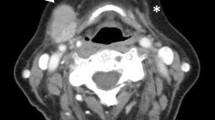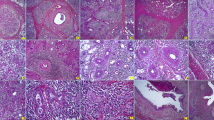Abstract
Küttner tumor is an uncommon cause of salivary gland enlargement that most frequently affects the submandibular gland. More recently it has been considered a manifestation of IgG4-related disease (IgG4-RD) and synonymous with chronic sclerosing sialadenitis (CSS). We present a series of cases to emphasize this clinical entity as a disease pattern and presentation that is separate from IgG4-RD. Retrospective case series of 3 patients with unilateral salivary gland enlargement, or “Küttner tumor,” histologically classified as “chronic sclerosing sialadenitis,” The clinical history, radiology reports, laboratory studies, and pathology slides were reviewed for each case. Radiology showed discrete unilateral mass-like lesions in all three cases. Immunohistochemistry showed reduced tissue IgG4-positive plasma cells in two cases and increased numbers in one case, but insufficient to diagnose IgG4-RD. Storiform fibrosis was not seen in all cases and did not coincide with increased IgG4-positive plasma cells. A systemic workup, including serum IgG4 levels in two cases, was normal. A brief review of the literature on the spectrum of salivary gland involvement by IgG4-RD is presented. Küttner tumor is not necessarily the same as chronic sclerosing sialadenitis and is not always associated with IgG4-related disease. This report includes the second documented case of Küttner tumor of the sublingual gland.



Similar content being viewed by others
References
Deshpande V, et al. Consensus statement on the pathology of IgG4-related disease. Mod Pathol. 2012;25(9):1181–92.
Wallace ZS, et al. The 2019 American College of Rheumatology/European League against rheumatism classification criteria for IgG4-related disease. Arthritis Rheumatol. 2020;72(1):7–19.
Küttner H. Uber entzundiche Tumoren der Submaaxillar-speicheldruse. Beiträge zur klinischen Chirurgie. 1896;15:815–34.
Geyer JT, et al. Chronic sclerosing sialadenitis (Kuttner tumor) is an IgG4-associated disease. Am J Surg Pathol. 2010;34(2):202–10.
Verdijk RM, et al. Raised numbers of IgG4-positive plasma cells are a common histopathological finding in orbital xanthogranulomatous disease. Orbit. 2014;33(1):17–22.
Lehman JS, Smyrk TC, Pittelkow MR. Increased immunoglobulin (Ig) G4-positive plasma cell density and IgG4/IgG ratio are not specific for IgG4-related disease in the skin. Am J Clin Pathol. 2014;141(2):234–8.
Stone JH, Zen Y, Deshpande V. IgG4-related disease. N Engl J Med. 2012;366(6):539–51.
Khosroshahi A, et al. International consensus guidance statement on the management and treatment of IgG4-related disease. Arthritis Rheumatol. 2015;67(7):1688–99.
Rapidis AD, et al. Tumors of the submandibular gland: clinicopathologic analysis of 23 patients. J Oral Maxillofac Surg. 2004;62(10):1203–8.
Hong X, et al. Differential diagnosis of IgG4-related sialadenitis, primary Sjogren syndrome, and chronic obstructive submandibular sialadenitis. Br J Oral Maxillofac Surg. 2017;55(2):179–84.
Melo JC, Kitsko D, Reyes-Múgica M. Pediatric chronic sclerosing sialadenitis: Küttner tumor. Pediatr Dev Pathol. 2012;15(2):165–9.
Harrison JD, Epivatianos A, Bhatia SN. Role of microliths in the aetiology of chronic submandibular sialadenitis: a clinicopathological investigation of 154 cases. Histopathology. 1997;31(3):237–51.
Chan JK. Kuttner tumor (chronic sclerosing sialadenitis) of the submandibular gland: an underrecognized entity. Adv Anat Pathol. 1998;5(4):239–51.
Kitagawa S, et al. Abundant IgG4-positive plasma cell infiltration characterizes chronic sclerosing sialadenitis (Küttner’s tumor). Am J Surg Pathol. 2005;29(6):783–91.
Kamisawa T, et al. IgG4-related sclerosing disease incorporating sclerosing pancreatitis, cholangitis, sialadenitis and retroperitoneal fibrosis with lymphadenopathy. Pancreatology. 2006;6(1–2):132–7.
Fujita A, et al. IgG4-related disease of the head and neck: CT and MR imaging manifestations. Radiographics. 2012;32(7):1945–58.
Katsura M, et al. Radiological features of IgG4-related disease in the head, neck, and brain. Neuroradiology. 2012;54(8):873–82.
Peuraharju E, et al. Sclerosing sialadenitis of the submandibular gland is rarely an immunoglobulin G4-related disease in the Finnish population. Mod Pathol. 2019;33:551–9.
Harrison JD, Rodriguez-Justo M. IgG4-related sialadenitis is rare: histopathological investigation of 129 cases of chronic submandibular sialadenitis. Histopathology. 2013;63(1):96–102.
Strehl JD, Hartmann A, Agaimy A. Numerous IgG4-positive plasma cells are ubiquitous in diverse localised non-specific chronic inflammatory conditions and need to be distinguished from IgG4-related systemic disorders. J Clin Pathol. 2011;64(3):237–43.
Liu Y, et al. Salivary gland involvement disparities in clinical characteristics of IgG4-related disease: a retrospective study of 428 patients. Rheumatology (Oxford). 2020;59(3):634–40.
Funding
No funding obtained.
Author information
Authors and Affiliations
Corresponding author
Ethics declarations
Conflict of interest
Kathryn S. Marcus, BS: No conflict of interest to disclose; Henry T. Hoffman, MD: Research consultant for COOK Medical; contributing author for UpToDate; research consultant for IotaMotion®; Anand Rajan KD, MBBS: No conflict of interest to disclose.
Ethical Approval
The study was determined to meet the regulatory requirements for the protection of human subjects and approved by the University of Iowa Human Subjects Office/Institutional Review Board (IRB ID #: 201906740).
Additional information
Publisher's Note
Springer Nature remains neutral with regard to jurisdictional claims in published maps and institutional affiliations.
Rights and permissions
About this article
Cite this article
Marcus, K.S., Hoffman, H.T. & Rajan KD, A. Not All Küttner Tumors Are IgG4-Related Disease (IgG4-RD). Head and Neck Pathol 15, 1322–1327 (2021). https://doi.org/10.1007/s12105-020-01268-3
Received:
Accepted:
Published:
Issue Date:
DOI: https://doi.org/10.1007/s12105-020-01268-3




